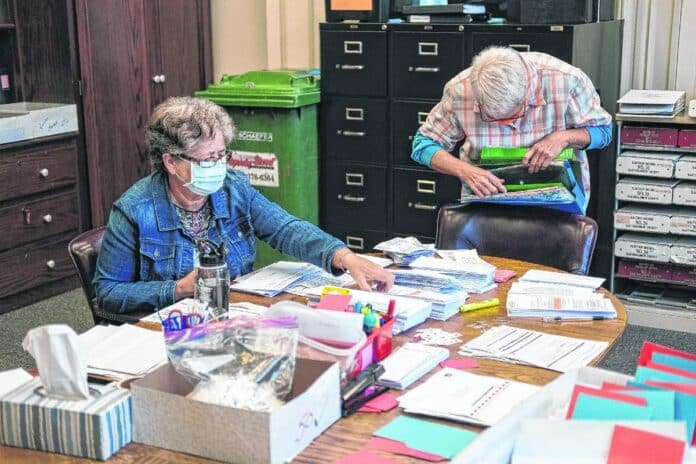
Bartholomew County election officials have received nearly $32,000 in federal aid to cover the larger-than-expected price tag of running this year’s primary and general elections.
Central to the soaring costs of running the elections this year are expenses associated with efforts to prevent the spread of COVID-19 at polling locations and surging demand for absentee-by-mail ballots, including unprecedented amounts of paper, postage, envelopes and personal protective equipment not provided by the state, said Bartholomew County Clerk Jay Phelps.
The end result, Phelps said, was ballooning costs in the primary that swelled to about $102,460 — an estimated $20,000 over budget — which left about $91,039 for the general election. General elections tend to be more costly than primaries due to increased voter turn-out, supplies, staff and advertising.
Local election officials estimate that it will cost $104,000 to conduct the Nov. 3 presidential election.
[sc:text-divider text-divider-title=”Story continues below gallery” ]Click here to purchase photos from this gallery
“The previous year in August is when we normally have budget sessions,” Phelps said. “In August 2019, we had no idea that COVID-19 even existed or that it would hit us the way that it did, so that was not put into our funding. Just the increase in voting by mail, that has been a very expensive cost to the county, and I know we’re not the only ones. It’s been statewide.”
Federal aid
The pandemic, which erupted this spring in the middle of state primaries, forced many states to delay elections, including Indiana, which pushed back its primary from May 5 to June 2, The Associated Press reported. Local election administrators across the country also dealt with poll worker shortages, polling place changes and an explosion of absentee ballots.
A record 8,313 Bartholomew County voters cast ballots through the mail in the primary, more than the combined total of all absentee mail-in ballots cast in the county in every presidential primary and general election since at least 2008, according to county records.
Even before the pandemic, many election offices across the country typically were working under tight budget constraints, according to wire reports. Now they are having to juggle how to process a flood of absentee ballot requests, which can be more costly.
It is not common for elections in Bartholomew County to run over budget, Phelps said.
The 2016 and 2012 election seasons, including primaries, were roughly a combined $44,700 under budget, according to county figures. A total of $258,277 was budgeted for the 2020 election season, though that figure includes around $64,777 in salaries and benefits for full-time election staff, leaving about $193,500 to run the primary and general elections.
However, the Indiana Secretary of State’s Office extended local election officials a lifeline this week, awarding Bartholomew County $31,841.73 of the state’s allotment of federal money under the 2020 Coronavirus Aid, Relief and Economic Security (CARES) Act to reimburse the county for costs in excess of its election budget related to the pandemic, according to a copy of a Sept. 15 award letter.
Phelps said he had requested $34,000 in August and got reimbursed for nearly everything he had asked for due in large part to only 50 of Indiana’s 92 counties applying for the aid.
The estimated $104,000 price tag for running the general election includes $33,000 for poll workers — which make $180 to $200 per day — $20,000 for postage, $15,000 for ballots and supplies, $12,000 on a voting machine maintenance agreement, $10,000 for employee overtime and Election Day employees, $10,000 on advertising and $4,000 on renting vote centers.
Phelps anticipates that CARES Act money should be enough to get his office through the November election, but he may request additional reimbursements from the state after the election. Counties have until Dec. 1 to request reimbursements for the general election from the Indiana Secretary of State’s Office under the CARES Act.
“As we continue to move forward between now and Nov. 3, we’ll keep track of any additional expenses due to COVID for the reimbursement for the general election,” Phelps said.
Voting by mail
One significant cost during the general election will be absentee-by-mail ballots, which cost the county between $1.15 and $1.65 per ballot in postage, depending on whether voters use the state’s online system to request them, which is less expensive than mailing ballot applications to voters.
The cost of sending the actual ballot is 65 cents, plus 50 cents for the postage on the return envelope, Phelps said. It costs 50 cents to send out the ballot application.
However, that does not include the cost of the paper, envelopes and other supplies need to send out the ballots.
On Monday, local election officials sent out a record 3,661 absentee-by-mail ballots in a single day, costing $4,210.15 in postage, Phelps said. About half of those ballots were requested directly through the Bartholomew County Clerk’s Office, rather than the state’s online system, which cost the county an additional $915.25 to mail out paper ballot applications, raising the overall total to $5,125.40.
And that was just the first round, Phelps said.
Currently, local election officials are anticipating a record 12,000 to 13,000 voters to request absentee-by-mail ballots for the general election. But officials can see that number easily jumping to 17,000 to 18,000 — or more — depending on how the pandemic evolves as the election approaches.
If 18,000 voters were to request absentee-by-mail ballots, it would cost the county $20,700 to mail the ballots to voters and would require around 95,940 sheets of paper and 36,000 envelopes, as well as 18,000 scantron cards and protective sleeves for the scantron cards.
It could also cost the county an additional $9,000 depending on how many of those voters request ballots directly through the clerk’s office instead of the state’s online system.
As of Friday morning, 5,145 voters had requested absentee-by-mail ballots for the general election, up 457 from Tuesday. By comparison, a total of 1,333 absentee mail-in votes were cast during the 2016 presidential election and 1,346 were cast in the 2012 election.
Phelps said he is confident that his office will have the supplies and money needed to run the general election and meet the soaring demand for absentee-by-mail ballots.
“Because we are in an unprecedented election, we are checking our supplies every other day to make sure what we have and what we need,” Phelps said. “We’re constantly ordering, we’re constantly trying to stay up with the needs and we’re constantly buying boxes of paper. As of right now, I truly believe we can stay stocked up and stay ahead of schedule.”
“We’re ready to meet that challenge,” he added.
[sc:pullout-title pullout-title=”Where to learn more” ][sc:pullout-text-begin]
Visit indianavoters.in.gov to register to vote, request an absentee-by-mail ballot and to see who is on the ballot.
[sc:pullout-text-end]




